"Cheers to a new year and another chance for us to get it right." -Oprah Winfrey
We've just completed another trip around the Sun, both in terms of the calendar year, and also the way astronomers measure it, by returning once again to perihelion, the closest point in our orbit to the Sun.
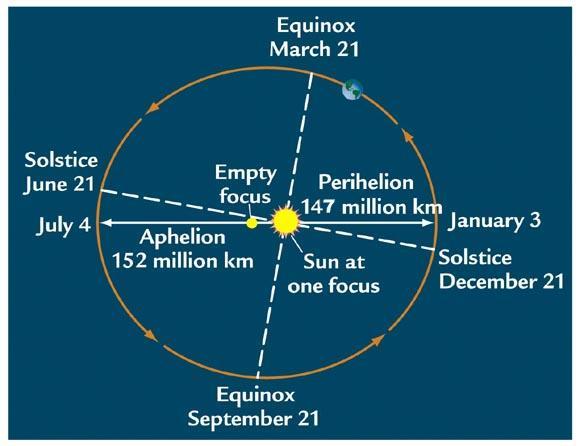
If you look up at the sky, and you watch the Sun, the Moon, and the planets all move through it, you'll notice something spectacular.
To within a very small separation in the sky, the Sun, the Moon, and each of the planets (Venus and Saturn in this picture) all follow the same path!
Why is this?
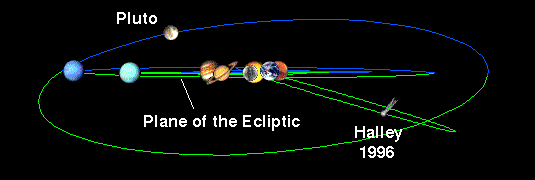
It's because the ecliptic plane -- the plane of the Earth's orbit around the Sun -- is the same plane that all the other planets follow! To within about 7 degrees, all eight of the planets, including the asteroid belt and the Kuiper belt, orbit about the Sun in the same plane. (Individual objects, such as Halley's Comet or Pluto, are out of the ecliptic plane due to ancient gravitational interactions.)
But this ecliptic plane doesn't line up with Earth's equator! Why not?
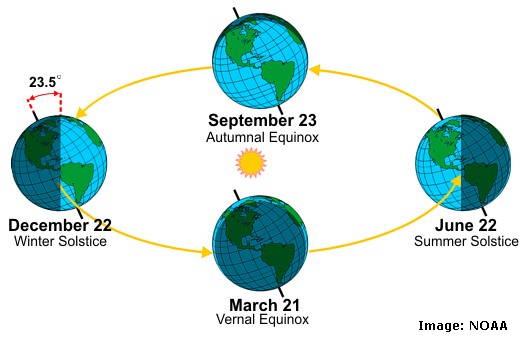
Because we rotate on our axis, which isn't arbitrarily aligned with the ecliptic plane. Like pretty much all the planets do, in fact. Sure, Mercury and Jupiter are closely aligned with the ecliptic plane, but Uranus and Venus couldn't be more anti-aligned.
There's also the Milky Way galaxy, visible in dark skies, which carves a path through our night sky.
You will notice a very bright object in the image above, to the left of the Milky Way. That's the planet Jupiter!
And you might ask whether our Milky Way Galaxy was either aligned with the ecliptic plane or with the Earth's equator. What do we find?

Not at all. The galaxy is tilted at about 60 degrees with respect to the ecliptic plane, which should indicate that there's no relationship between the Earth's axis, the plane of the planets orbiting the Sun, and the Sun and all the other stars moving through the Milky Way Galaxy.
But there's one more thing we can look at, beyond the Earth, beyond the Sun and the planets, even out beyond the galaxy, to see if there are any interesting alignments in our Universe.
The Cosmic Microwave Background, of course. This relic radiation -- left over from the big bang -- is a fingerprint from the Universe when it was only 380,000 years old.
Here's the odd thing. A few months ago, I wrote a post on geocentrism, and talked about some very simple observations you could make showing that the Earth was not at the center, but moved just like the other planets around the Sun. Yet little did I know that I would be faced with the following argument:
The plane of the ecliptic- that is, the 23.5 degree inclination of the Sun and the planets with respect to Earth in their annual cycle of daily orbits- happens to be highly improbably aligned with the so-called "Axis of Evil" discovered to the very great shock of cosmologists studying the cosmic mocrowave background (CMB) in 2005, and dubbed by them the "Axis of Evil".
This Axis of Evil is aligned in astonishingly precise ways with:
1. The Galactic North Pole
2. The ecliptic plane
3. The equinoxes
The complete ensemble of such orientations being unlikely to a combined degree of approximately one in one hundred billion.
So, let's take a look at this so-called Axis of Evil. If I take the map from the microwave sky, I can break it down into different regions of progressively smaller and smaller sizes, and look at the fluctuations on those scales.
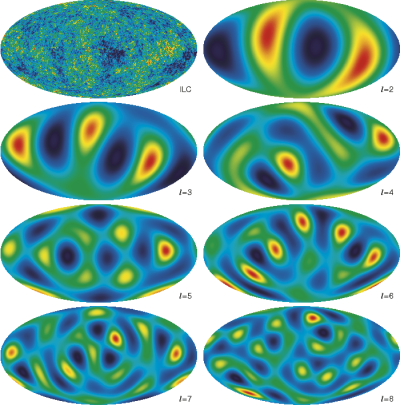
In physics and mathematics, we call this a multipole expansion, and we can look at the different "moments" independently.
When we do this, we find that the first moment -- the monopole term (just the average temperature) -- is nothing special.
Neither is the dipole term (bottom graph), which shows our motion through the sky. In fact, the small angular scales don't show anything peculiar either.
But back in 2005, when scientists first looked at it in detail, something looked slightly amiss for the 3rd and 4th largest scales: the quadrupole and octopole moments.
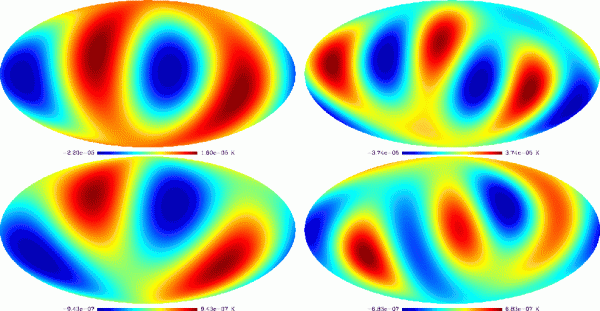
It was initially claimed that this was significant: these two terms appeared to be aligned with the Earth's axial tilt in a very unusual way. In such a way, in fact, that there was only a 1-in-2,000 chance that it would happen randomly.
But there was a problem with the analysis. You see, the map of the microwave sky I've been showing you doesn't look like this. It really looks like this:
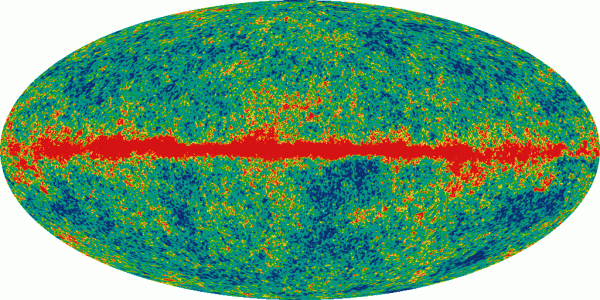
What's all that crap in the middle? That's the gas, dust, stars, etc., coming mostly from within our own galaxy. The problem is that it both absorbs and emits its own radiation, and that needs to be properly accounted for. When you change your model of that gas and dust, it drastically changes these quadrupole and octopole moments.
So what once looked like an extremely unlikely alignment:
Now turns out to be about as likely as you guessing the random number I chose between one and ten.
(It was eight.)
But I was very happy to hear this argument coming from someone who believes the Earth is 6,000 years old! Why?
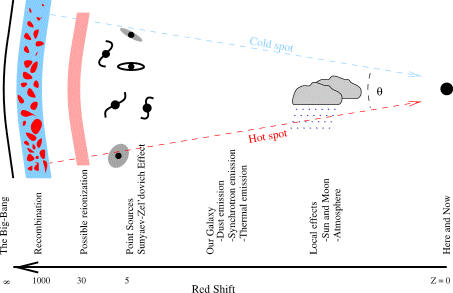
Because the only way the Cosmic Microwave Background is meaningful in any way is if you accept the Big Bang picture of the Universe, where it's many billions of years (13.7, to be precise) old!
It gives me hope for the new year, and not only makes me feel like we're making progress, but also that the 13,700,000,001st year may be an even better one than the one before!


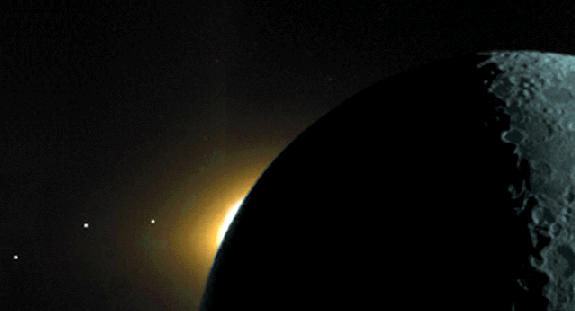





Müziklerle coÅarak yeni yıla giren Alex ve dostları, Türkiyeâde kutlamaların olmazsa olmazı dansözün sahne almasıyla iyice keyiflendi. Dansözün kıvrak hareketlerine, Alexâin, vatandaÅı olan Brezilyalı konukları da sambayla eÅlik etti. MuhteÅem geçen gecede bir de doÄum günü kutlandı.
Fascinating post as always! Happy New Year!
Ethan, I respect that this is your (totally awesome) blog; but please, for the sake of everything good and decent in this world, do not quote Oprah about anything, unless you intend to rip it to shreds. Put it in Comic Sans or something, just to humor us, if nothing else.
Just ask yourself: what would Macho Man Randy Savage do? I think you know the answer.
Now for a more serious comment....
I notice that in the second picture that the Moon is in the same phase every time its picture was taken in that composite. (The truth is, I don't know how to tell if those composite shots are astronomically accurate, or if maybe they were a bit of artistic license by the photographer.) If they are accurate, then I'm also not sure if I understand how the Moon's position would differ relative to the ecliptic as it changes in phase.
I'm guessing that over time the Moon looks like it is oscillating about a line parallel to the one in the picture, but I'm not sure where the peaks would be (relative to the Moon's phase), or how far apart they would appear to be. If that is the case, does it remain relatively constant (excepting for very long-term changes like Earth's axial tilt), or change from year to year? I hope this question makes some sense, but if you can answer it, I would appreciate it very much.
I'm pretty sure those exposures were taken over a period of a few hours, not days or months -- just charting the motion of the moon and the planets during the night.
Very nice explanation. Forgive me for not nitpicking.
I need to follow your links and understand the axis of evil and multipole expansion stuff.
(OT ) Partial solar eclipse Tuesday morning, as seen from Sweden (two images)
http://www.dn.se/nyheter/sverige/har-tacks-solen-av-manen
Alas, locally, our sky was overcast :(
This is all fascinating, but I think we need to focus on how the planets are almost all in alignment. If that happens we'll have much more pressing matters than the age of the earth. Big, angry, Cthulhu-shaped matters.
if you take the age of the earth, 6000 years, and divide by the number of digits on human hands, 10, you get 60, which is exactly the number of degrees the galactic plane and the ecliptic are tilted with respect to each other! coincidence? NO! this is gods plan! all we gotta do to find out how many fingers any aliens in other solar systems have is to measure the angle their solar system makes to the galactic plane and divide it into 6000 and voila! you get how many digits they have! as an suggestion, i recommend we only attempt to communicate with bilaterally symmetric aliens that have an odd number of digits. that way they can't give us the finger.
@rob:
6000/10=600.
I'm fairly sure you were being snarky, but... you know.
you can't expect creationist science to be held to the same rigorous, mathematical, evidence based standards as reductionist western allopathic science do ya?
(yeah, snark)
Ethan
I've read your explanation and followed your links on multipole expansions, axis of evil, the crap in the CMB, the considerations of the 3rd and 4th. And I understand that the odds of alignment drop from high to 1 in 8.
But I still don't understand the reasoning and the why and the meaning. So here go my specific questions.
Does each multipole expansion (e.g. dipole, quadrapole, octopole) in theory correlate to some physical observable or not?
Your 8 chart graph of the CMB and the series of expansions is all without crap. Then you show a CMB with crap graph; is the next graph below (an octopole graph) with or without crap.? Specifically is there as 8 chart series of charts with crap?
"When you change your model of that gas and dust, it drastically changes these quadrupole and octopole moments." It'd be nice to see a series of (e.g. octopole) graphs with different models. Are we talking about different working (i.e. reasonable physical) models or different unreasonable (i.e. don't map to observation) models?
I just want to understand what is being explained here and I don't. thanks for any help.
Ethan
One other related thought/question. The various multipole expansion charts that you show are very similar to recent IceCube cosmic ray chart.
http://icecube.wisc.edu/~desiati/activity/anisotropy/large/
Can you help me understand both your above explanation better; as well, in context of the meaning of the cosmic ray charts which show large scale unexplained anistropy?
Does this suggest that at large scale the universe might be anistropic?
But I want to understand how to read the charts; not just jump to a word conclusion/question. Thanks.
Hey, first time commenter here (I think). I love this blog, but I wonder about your choice of lead-in quote...
That is such an ubiquitous sentiment that you could have found a similar quote anywhere.
Oprah Winfrey, as America's most trusted female television personality, publicly endorses anti-vax celebrities, directly leading to stupid soccer moms exposing their children to potentially deadly, preventable diseases. The fact that kids are already dying from this advice kinda makes her a murderer. It's no different than someone bringing about trampling deaths by jokingly crying "FIRE" in a crowded theatre, except that she's making money from her crime.
The only thing Oprah could do to "get it right" would be to publicly denounce all the anti-medical advice she's given over the years and hang herself on stage.
Ethan: Sorry, you are wrong.
The alignment in the CMB is precisely with the equinox and ecliptic.
It gets much worse for you.
The universe is also, in a presently inexplicable way, polarizing the light from quasars along precisely the same CMB Axis which has been determined in *multiple independent peer reviewed papers* to align with the Earth's ecliptic and equinoxes.
See for details:
http://arxiv.org/pdf/1011.2425v2
Excerpt:
"First of all, there is a statistically very unlikely planarity between quadrupole and octopole, which is seen in different releases of the data as well as in different statistical analyses [36â40], and the octopole is unexpectedly planar by itself. Similarly, one can employ different vectorial and tensorial decompositions of the multipoles to see that *there is a very easily identifiable preferred axis, the cosmological dipole once again; that is, the normal vectors to the planes determined by the quadrupole and the octopole (there are four of them) point all in the same direction, that of the ecliptic or equinox*."
Try again, Ethan.
Harder.
PS: Did you learn your lesson yet, from your botch job on the phases of Venus?
OK says: "I've read your explanation and followed your links on multipole expansions, axis of evil, the crap in the CMB, the considerations of the 3rd and 4th. And I understand that the odds of alignment drop from high to 1 in 8."
>> You do? That's amazing. Because Ethan doesn't. He pulled the number out of thin air, so far as any reader of this hilarious botch would be able to tell.
Now Schwarz, Starkam, Corpi, Huterer, et al, published a paper in Astrophysics Journal,
based on one hundred thousand Monte Carlo simulations of a Gaussian, isotropic CMB. They tell you exactly how they came up with their probability number, which is rather different from Ethan's bunny hat bit of hand waving hooey. Read about it here:
(includes link to the original: http://cerncourier.com/cws/article/cern/29210 )
Excerpts:
"the new method revealed at high statistical significance (99.9% CL) that the observed quadrupole and octopole are inconsistent with a Gaussian random, statistically isotropic sky (the generic prediction of inflation)"
and:
"No significant correlation with the Milky Way was found, but a strong correlation with the orientation of the solar system (ecliptic plane) and with its motion (measured as the CMB dipole) showed up.
A comparison with 100,000 skies generated by Monte Carlo shows that each of those correlations alone is unlikely at more than 99% CL. "
Did you get that, OK? *Each* of those correlations is unlikely at the indicated level.
I hope you will give serious consideration to what this does to Ethan's 1 in 8 bunny hat trick
And you waited from January until September to share with us! How...special.
OK says: But I still don't understand the reasoning and the why and the meaning. So here go my specific questions. Does each multipole expansion (e.g. dipole, quadrapole, octopole) in theory correlate to some physical observable or not?
>> Yes. They all correlate to temperature variations in the CMB. See here:
http://www.phys.cwru.edu/projects/mpvectors/
********************************************
OK: Your 8 chart graph of the CMB and the series of expansions is all without crap. Then you show a CMB with crap graph; is the next graph below (an octopole graph) with or without crap.?
>> It is foreground-cleaned (without "crap").
*********************
Specifically is there as 8 chart series of charts with crap?
>> The "crap" must be removed in order to establish the multipole vectors (which are spherical functions). The "crap" cuts off a part of the sky we need to see, so the ferociously brilliant guys working on this found a way to distinguish between the CMB and the galactic foreground (crap).
Ethan hopes he can ascribe the alignments to foreground contamination. As we shall see in a moment, this is highly unlikely.
********************************
OK: "When you change your model of that gas and dust, it drastically changes these quadrupole and octopole moments."
>> Really? I am sure Ethan has a peer reviewed paper which drastically changes these moments? Oh, he doesn't? Hmmm. I wonder why? Oh, that's right. He would have to go up against not only Max Tegmark if he wanted to try publishing such a "drastically changed" quadrupole and octupole moments, but also the long list of independent peer reviewed papers which have derived the same quad and octupole as Max.
***************************
It'd be nice to see a series of (e.g. octopole) graphs with different models.
>> If you rad the paper Max tegmark wrote, that I will link below, you will understand why you can;t do that. None of the opposing models (if there are any) can get published, because they would have to identify a flaw in Max's peer reviewed paper, or develop a model which did not contradict it.
It is reasonable, after eight years of such an astonishing anomaly, to suppose they can't.
***********************************************
OK: Are we talking about different working (i.e. reasonable physical) models or different unreasonable (i.e. don't map to observation) models?
>> There is no published foreground cleaning model that challenges in its important elements the one you can read below, so far as I know.
Obviously Ethan doesn't know of one either, or I assume he would have cited it.
We are talking about a model which has been excruciatingly subjected to the most intense challenges over the last seven or eight years. The results, showing the Axis, are now extremely robust, and the foreground contamination argument Ethan tries above actually indicates that the alignments are *more statistically significant*, not less. The improved model for foreground cleaning used in the images of Max Tegmark in Ethan's article is published here:
http://arxiv.org/pdf/astro-ph/0603369v3
Excerpt:
"Moving the quadrupole axis in a random direction would typically degrade the alignment, so this is consistent with the hypothesis that *the true alignment is still better* and that *this* is partially masked by fore- grounds." (emphasis added)
OK: I just want to understand what is being explained here and I don't. thanks for any help.
>> Ethan badly botched this. Here is an excellent paper, and very recent, which will sum up the absolutely astonishing alignment we now see not only in the CMB but *also* in the polarization of light from quasars no matter in which direction we look:
http://arxiv.org/pdf/1011.2425v2
Excerpt:
"First of all, there is a statistically very unlikely planarity between quadrupole and octopole, which is seen in different releases of the data as well as in different statistical analyses [36â40], and the octopole is unexpectedly planar by itself....there is a very easily identifiable preferred axis, the cosmological dipole once again; that is, the normal vectors to the planes determined by the quadrupole and the octopole (there are four of them) point all in the same direction, that of the ecliptic or equinox....Let us stress here that the most important feature of all the observational findings reviewed in the previous section is the fact that they require a mechanism operating on unbelievably large scales, which generates coherence among disparate light signals from diverse sources".
Buckle up.
There are big, big changes afoot in cosmology......
OK says: But I still don't understand the reasoning and the why and the meaning. So here go my specific questions. Does each multipole expansion (e.g. dipole, quadrapole, octopole) in theory correlate to some physical observable or not?
>> Yes. They all correlate to temperature variations in the CMB. See here:
http://www.phys.cwru.edu/projects/mpvectors/
********************************************
OK: Your 8 chart graph of the CMB and the series of expansions is all without crap. Then you show a CMB with crap graph; is the next graph below (an octopole graph) with or without crap.?
>> It is foreground-cleaned (without "crap").
*********************
Specifically is there as 8 chart series of charts with crap?
>> The "crap" must be removed in order to establish the multipole vectors (which are spherical functions). The "crap" cuts off a part of the sky we need to see, so the ferociously brilliant guys working on this found a way to distinguish between the CMB and the galactic foreground (crap).
Ethan hopes he can ascribe the alignments to foreground contamination. As we shall see in a moment, this is highly unlikely.
********************************
OK: "When you change your model of that gas and dust, it drastically changes these quadrupole and octopole moments."
>> Really? I am sure Ethan has a peer reviewed paper which drastically changes these moments? Oh, he doesn't? Hmmm. I wonder why? Oh, that's right. He would have to go up against not only Max Tegmark if he wanted to try publishing such "drastically changed" quadrupole and octupole moments, but also the long list of independent peer reviewed papers which have derived the same quad and octupole as Max.
***************************
It'd be nice to see a series of (e.g. octopole) graphs with different models.
>> If you rad the paper Max tegmark wrote, that I will link below, you will understand why you can;t do that. None of the opposing models (if there are any) can get published, because they would have to identify a flaw in Max's peer reviewed paper, or develop a model which did not contradict it.
It is reasonable, after eight years of such an astonishing anomaly, to suppose they can't.
***********************************************
OK: Are we talking about different working (i.e. reasonable physical) models or different unreasonable (i.e. don't map to observation) models?
>> There is no published foreground cleaning model that challenges in its important elements the one you can read below, so far as I know.
Obviously Ethan doesn't know of one either, or I assume he would have cited it.
We are talking about a model which has been excruciatingly subjected to the most intense challenges over the last seven or eight years. The results, showing the Axis, are now extremely robust, and the foreground contamination argument Ethan tries above actually indicates that the alignments are *more statistically significant*, not less. The improved model for foreground cleaning used in the images of Max Tegmark in Ethan's article is published here:
http://arxiv.org/pdf/astro-ph/0603369v3
Excerpt:
"Moving the quadrupole axis in a random direction would typically degrade the alignment, so this is consistent with the hypothesis that *the true alignment is still better* and that *this* is partially masked by fore- grounds." (emphasis added)
OK: I just want to understand what is being explained here and I don't. thanks for any help.
>> Ethan badly botched this. Here is an excellent paper, and very recent, which will sum up the absolutely astonishing alignment we now see not only in the CMB but *also* in the polarization of light from quasars no matter in which direction we look:
http://arxiv.org/pdf/1011.2425v2
Excerpt:
"First of all, there is a statistically very unlikely planarity between quadrupole and octopole, which is seen in different releases of the data as well as in different statistical analyses [36â40], and the octopole is unexpectedly planar by itself....there is a very easily identifiable preferred axis, the cosmological dipole once again; that is, the normal vectors to the planes determined by the quadrupole and the octopole (there are four of them) point all in the same direction, that of the ecliptic or equinox....Let us stress here that the most important feature of all the observational findings reviewed in the previous section is the fact that they require a mechanism operating on unbelievably large scales, which generates coherence among disparate light signals from diverse sources".
Buckle up.
There are big, big changes afoot in cosmology......
Rick,
You give great credence to the quadrupole/octopole alignment and its meaning for our Universe; I have seen you on other sites voicing your support for geocentrism as well. Now, you quote my friend Federico Urban's paper and claim, based on the alignment of these low multipoles of the cosmic microwave background, what, exactly? That there is some connection to the Earth itself?
First off, you need to understand how statistically insignificant the quadrupole and octopole are for our Universe, and how dangerous it is to draw conclusions about our entire sky at low multipoles when you don't have the entire sky (and we don't; there is a mask placed over the galactic plane for all analysis, which is what I tried to tell you above).
Second, you are clearly cherry-picking results, discounting the O'Dwyer paper referenced above and ignoring the later work of George Efstathiou.
Third, based on your accusations of slander and libel against you from around the internet, I would have expected you'd be the last person to engage in ad hominem attacks (bunny hat tricks? thin air? botch job?) instead of sticking to the physics.
But maybe you really are genuinely interested in discourse and debate. So I'll tell you what: invite me to the next conference you have on geocentrism to speak with and debate your group. Send me the abstracts from the talks that will be there and I will happily take on the central points of those arguments.
Ethan: You give great credence to the quadrupole/octopole alignment and its meaning for our Universe;
>> I am certainly not alone in this regard.
Ethen: I have seen you on other sites voicing your support for geocentrism as well. Now, you quote my friend Federico Urban's paper and claim, based on the alignment of these low multipoles of the cosmic microwave background, what, exactly?
>> That there is a very unexpected, and presently unexplained, physical law of nature which is acting to define a preferred axis across the entire visible universe, in direct contradiction to the expectations of concordance cosmology and the Copernican Principle itself.
Ethan: That there is some connection to the Earth itself?
>> Obviously. This connection is precisely what renders too observations so interesting :-)
PS: Please thank your friend Federico Urban for his excellent paper, and tell him I will be following his further work with great interest.
Ethan: First off, you need to understand how statistically insignificant the quadrupole and octopole are for our Universe, and how dangerous it is to draw conclusions about our entire sky at low multipoles when you don't have the entire sky (and we don't; there is a mask placed over the galactic plane for all analysis, which is what I tried to tell you above).
>> Ethan, the simple truth is that you are seeking to downplay the significance of the multiple, independent studies cited by Professor Urban. He has shown that the Axis involves not only the CMB, but the polarization of light from quasars- along the same Axis!
This is a very, very significant challenge to the present consensus cosmology.
Ethan: Second, you are clearly cherry-picking results, discounting the O'Dwyer paper referenced above and ignoring the later work of George Efstathiou.
>> I checked again and find no citation in your post to either O'Dwyer or Afsathiou. Such citations would be appreciated.
Ethan: Third, based on your accusations of slander and libel against you from around the internet, I would have expected you'd be the last person to engage in ad hominem attacks (bunny hat tricks? thin air? botch job?) instead of sticking to the physics.
>> Point well taken, mea maxima culpa. I shall endeavor to dispense with such tactics, especially in light of your apparent intention to do the same. I freely wash the slate clean with regard to certain prior adoptions of similar tactics on your part........:-)
Ethan: But maybe you really are genuinely interested in discourse and debate. So I'll tell you what: invite me to the next conference you have on geocentrism to speak with and debate your group. Send me the abstracts from the talks that will be there and I will happily take on the central points of those arguments.
>> I would be delighted to convey this offer to the organizers, and would very much appreciate the opportunity to afford you a similar opportunity in what might be an even more interesting forum.
My email address is in the post- please send me your contact info.
Thank you so much Ethan, just searching around for your citations has yielded the following fascinating post (I have been fruitlessly trying to get some skinny on Planck and lo and behold!- thanks to your post I finally have found some):
http://scienceblogs.com/catdynamics/2009/07/is_cosmology_about_to_becom…
Excerpt:
".....more than one of the Planck groups redid the WMAP analysis partly as warmup for Planck and partly as a fishing expedition, and they get results very consistent with the WMAP5 release"
My one great fear now slightly ameliorated :-)
Please do contact me.
Rick,
The O'Dwyer paper was linked to above, but here is a direct link to it: http://arxiv.org/abs/astro-ph/0407027
The Efstathiou paper, as well, is older, but still holds up: http://arxiv.org/abs/astro-ph/0310207
The low-multipoles of the CMB have been the subject of much debate over the years in the community, and I have always been in the camp of the more conservative side, claiming that the uncertainties due to the galactic foreground subtraction and cosmic variance of such limited data availablility (and I am not alone, see here) are much more likely responsible for this mildly statistically significant (and it is mild, at only about 4-sigma in the most generous of analyses) event than new physics.
Remember, it isn't just foreground contamination at work here, there is a mask placed over the galactic plane and we are cutting out huge swaths of the sky when we do our analysis. So we are looking at huge areas of the sky with large sections cut out of them, and then drawing conclusions based on that. For the higher multipoles (small angular scales), this isn't a big deal at all, because we have plenty of unmasked regions. But for the lowest multipoles, this may well be a problem.
The polarization of quasar light is news to me; I will have to take a closer look at that.
Federico's work is certainly interesting, although his conclusions in the paper are far from what is considered accepted in the community.
If you wish to contact me, my information is available under the "contact" tab above. However, upon reading the information I have found around the web about your group, I am hesitant to conclude that there is an honesty there about having a scientific discourse.
There are a number of very good reasons to not only disfavor but to completely discard geocentrism; until I can be certain that you are honest in your scientific assessment of and approach to such phenomena, you must understand that I cannot commit to a meeting.
You cannot commit to a meeting? But I thought you just did?
Very well, Ethan, we will address your points one by one here on your blog- but remember, please, that your offer was accepted and mine wasn't.
The first citation is from 2004, and is utterly out of date. Its foundational assertions are effectively refuted here:
http://www-personal.umich.edu/~huterer/Papers/cmb_review.pdf
Excerpt:
"While not all of these alignments are statistically independent, their combined statistical significance is certainly greater than their individual significances; for example, given their mutual alignments, the conditional probability of the four normals lying so close to the ecliptic is less than 2%; the combined probability of the four normals being both so aligned with each other and so close to the ecliptic is less than 0.4% Ã 2% = 0.008%. These are therefore clearly surprising, highly statistically significant anomaliesâunexpected in the standard inflationary theory and the accepted cosmological model.
Particularly puzzling are the alignments with solar system features. CMB anisotropy should clearly not be correlated with our local habitat. While the observed correlations seem to hint that there is contamination by a foreground or perhaps by the scanning strategy of the telescope, closer inspection reveals that there is no obvious way to explain the observed correlations. Moreover, if their explanation is that they are a foreground, then that will likely exacerbate other anomalies that we will discuss in Section 4.2."
With regard to your second link, it is even older (2003), and is explicitly rebutted in the same paper, here:
"Another approach advocated by Efstathiou et al. [35] is to reconstruct the full-sky C(θ) from the partial sky and compare the reconstructed full-sky C(θ) (using, say S1/2) to the predictions of the model. ........As we have shown, the pixel-based two-point correlation function on the region of the sky outside a conservative galactic mask *is inconsistent with the predictions of the standard ÎCDM model for the identical pixel-based two-point correlation function on the identically masked sky*."
You admit you have not reviewed your friend's paper, the significance of which is to point out a polarization of quasars along the same CMB, Earth-oriented Axis.
Very well.
When you have done so you will see that there exists a preferred axis across the visible universe, oriented with earth's ecliptic and equinoxes, in direct contradiction to the predictions of Relativity and of the Copernican principle itself.
George Ellis and many others, including Clifton at Oxford, are pursuing similar theoretical frameworks involving the discarding of the Copernican principle in peer reviewed journals.
Ethan says: "There are a number of very good reasons to not only disfavor but to completely discard geocentrism"
> Oh? What, exactly? In fact Einstein has already told you that Relativity cannot prove a moving Earth. He says no absolute axis, direction, frame, or motion can be observationally established. I have now told you that the predictions of Einstein are refuted by the observed anisotropy in the CMB, in quasar polarization, and in the preferred periodic Earth- centered z-values in galaxy distributions out to a billion light years reported here:
http://arxiv.org/pdf/0711.4885v3
Ethan: until I can be certain that you are honest in your scientific assessment of and approach to such phenomena, you must understand that I cannot commit to a meeting.
>> The offer has been made. The ball is entirely in your court. If I do not hear from you, then you will certainly hear from me, in a forum that will prove, I expect, to be one you will perhaps regret having rejected.
Are you prepared to step up here, or not. Ethan?
I am sad to see that you have descended to the expedient of censoring my responses.
This says a great deal about you, and alas I cannot suggest that it speaks well about you.
Well, Planck has reported back to earth, and the anomalies still exist ( Planck Reveals an Almost Perfect Universe ). The Copernican Principle is now dismissed.
[[SPAM removed]]
"You cannot commit to a meeting? But I thought you just did?"
Ridiculous troll is obviously ridiculous.
Here is the bit you didn't read:
until I can be certain that you are honest in your scientific assessment of and approach to such phenomena
"I am sad to see that you have descended to the expedient of censoring my responses."
It's his "house".
Or is all private property theft to you?
Commie.
To Mark Wyatt: This is really incredible news. And thanks so much for the link [[SPAM removed]]. I will really be looking forward to the movie which I hear is scheduled for release this summer.
Ethan,
you seem to have gathered quite a creationists marketing fan club here, or they are some sofisticated spam bots.. either way.. should give the old spam filter some updates.
Cleaned up and unedited:
Well, Planck has reported back to earth, and the anomalies still exist ( Planck Reveals an Almost Perfect Universe- plus axis of evil ). The Copernican Principle is now dismissed.
http://www.newscientist.com/article/dn23301-planck-shows-almost-perfect…
Apparently proponents of geo-centrism are as fundamentally dishonest as creationist/ID folks. It would be interesting to find out how large the intersection of those two sets actually is.
wat leuk en leer zaam maar ik heb schijt aan leren
"So what once looked like an extremely unlikely alignment: . . . Now turns out to be about as likely as you guessing the random number I chose between one and ten. (It was eight.)"
So, . . . apart from your snarkiness . . . what you're saying -- and, still admitting -- is that the alignment of the C. M. B. with our Solar System is STILL unlikely, statistically speaking. No matter how great or how little the statistical improbability: It is still improbable.
Oh, and, by the way: The unlikelihood of my guessing your number between 1 and 100 is STILL higher (0.9) than the likelihood. It's the UNLIKELIHOOD that you have to account for, Ethan.
Hi Ethan - sorry to bother you, I just read the comments above and you said you were going to look into the polarization of distant quasar light. Did you get around to doing that...and if you did could you possibly tell me what came out of it?
The only thing that occurred to me reading the argument above, is that if this alignment is with the ecliptic, a stationary Earth is not the implication of that in any direct way. The ecliptic is the earth-sun system, where the path of the sun across the sky is either the sun around the earth or the earth around the sun. The anisotropy doesn't change anything as far as that goes.
also - would it be possible for you to ask Rick DeLano's permission for you to email me his contact details?